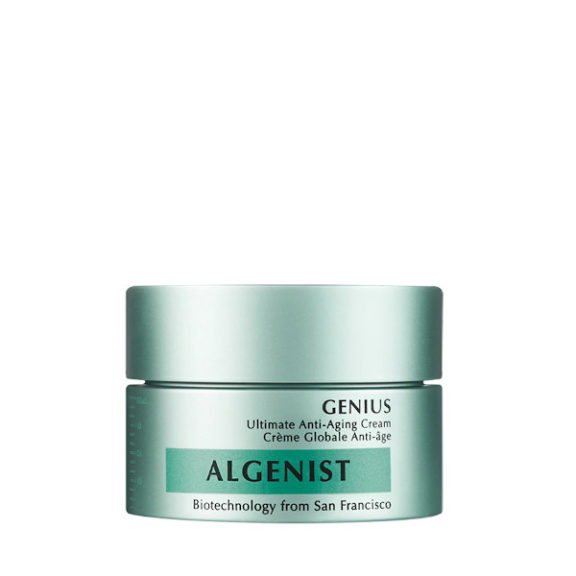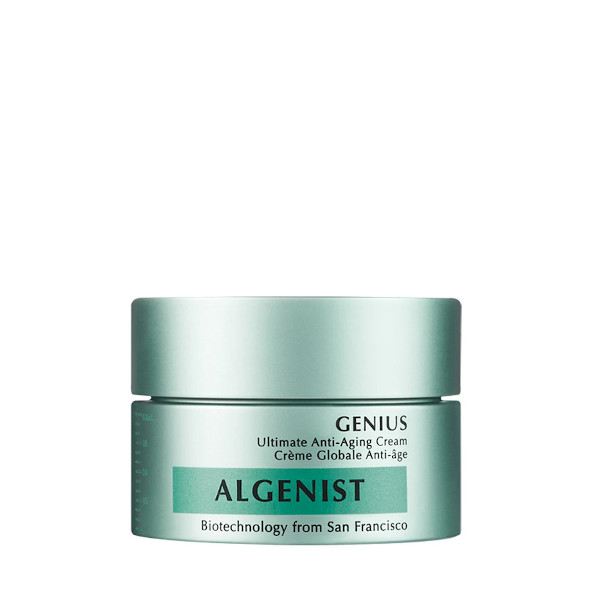GENIUS Ultimate Anti-Aging Cream
Expert Review
Let’s take a closer look at the science behind the advertised statements (or claims) for this popular vegan moisturizer.
Cosmetic Claims
ALGENIST makes eleven claims about their GENIUS Ultimate Anti-Aging Cream. The company says that these findings come from a test done on real people (in-vivo). However, we could not find any publically available details of such a study. We asked Algenist about this in-vivo study, but they refused to share the details with us and the public.
The claims Algenist makes are very specific and would be best supported by clinical/consumer studies. As we could not find any study data that would support these claims, we looked closer at the ingredient list.
-
Visibly restore the skin resiliency
-
Restores elasticity
-
Firmer, tighter, and more toned appearance
-
Visibly strengthens the most fragile skin texture
-
Minimizing the appearance of fine lines and deep wrinkles
-
Unveil skin’s youthful radiance
-
95% said dull skin is brighter in 10 days
-
91% said fragile skin texture appears reinforced within 10 days
-
95% said skin appears firmer, more resilient, and suppleness appears restored in 28 days
-
87% said forehead wrinkles, creases, and lines are visibly minimized within 28 days
Legend
Ingredient review and safety:
Ingredients listed here have skin conditioning, humectant, and emollient properties (such as Caprylic/Capric Triglyceride, Hydrogenated Polyisobutene, Glycerin, and Chlorella Protothecoides Oil). Based on these ingredients, we could partially support the claim: Minimizing the appearance of fine lines and deep wrinkles. However, for a true measure of how this cream works, it is best to have actual study information.
Water (Aqua, Eau), Caprylic/Capric Triglyceride, Hydrogenated Polyisobutene, Glycerin, Chlorella Protothecoides Oil, Dimethicone, Butylene Glycol, Glyceryl Stearate, PEG-100 Stearate, Butyrospermum Parkii (Shea) Butter, Pentylene Glycol, Potassium Cetyl Phosphate, Parachlorella Beijerinckii Exopolysaccharides, Collagen, Ceramide NP, Cynara Scolymus (Artichoke) Leaf Extract, Retinyl Palmitate, Astragalus Membranaceus Root Extract, Atractylodes Macrocephala Root Extract, Iris Florentina Root Extract, Bupleurum Falcatum Root Extract, Copper Lysinate/Prolinate, Methylglucoside Phosphate, Stearalkonium Bentonite, Acrylates/C10-30 Alkyl Acrylate Crosspolymer, Silica, Caprylyl Glycol, Sodium Hydroxide, Disodium EDTA, Ethylhexylglycerin, Cetyl Alcohol, Propylene Carbonate, Quartz, Phenoxyethanol, Leuconostoc/Radish Root Ferment Filtrate, Chlorphenesin, Fragrance (Parfum), Coumarin.
Allergen free?

Coumarin
Maximum concentrations do not exceed use guidelines?
Preservative free?

Chlorphenesin
Phenoxyethanol
Maximum concentrations do not exceed use guidelines?
EU restricted ingredient free?

Sodium Hydroxide
Maximum concentrations do not exceed use guidelines?
The ingredients contain one known fragrance allergen (Coumarin). Coumarin is a known sensitizer and has some systemic toxicity effects. The EU classifies it as a fragrance allergen. IFRA recommends its restriction to 0.089% for eye products and 0.11% for facial moisturizers.
There are two preservatives present in this formulation. Chlorphenesin prevents the growth of microorganisms. It is considered safe when used in cosmetics in the concentrations of up to 0.3%. Phenoxyethanol is a preservative that is considered safe to use in concentrations of up to 1%.
Finally, this cream contains Sodium Hydroxide, which is used to stabilize the pH in cosmetics. Sodium Hydroxide falls on the list of ingredients restricted to use, as it has shown to cause skin irritation at concentrations of 0.5% and higher. It also acts corrosively on the skin in concentrations of above 2%.
Conclusions

Pros
- Ingredients suggest that it is potentially able to minimize the appearance of fine lines and deep wrinkles.
Cons
- Algenist’s team is not willing to share any evidence of clinical studies that would be able to support any beneficial claims they make about this cream.
- We were not able to confirm whether Coumarin, Phenoxyethanol, Chlorphenesin, and Sodium Hydroxide follow the common safety guidelines and to what extent.

